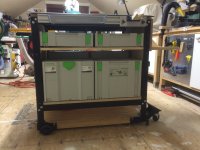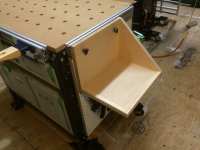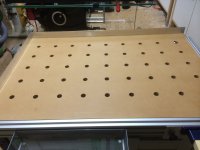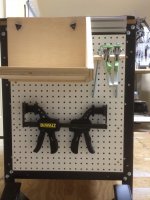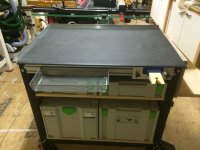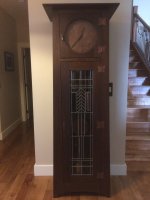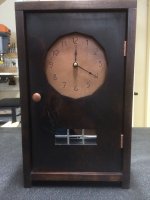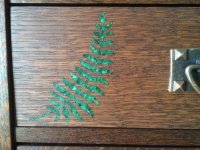My first post, be gentle [smile]
Shown here is my version of a homemade MFT/Storage Island. My shop is located in a 2nd floor bonus room in my house so everything is on mobile bases including this MFT, table saw, band saw, drill press, joiner, and more. This allows me to optimize usage of the small space. In addition to woodworking I also do copper smithing, stained glass , and enameling so the space is very multifunctional. I include these elements into the arts and crafts style furniture I build.
The steel frame for the MFT is from Rockler and the mobile base is available from Grizzly, Woodcraft, and others. The extrusions around the top of the MFT are from 8020. All the shelves are on pins so they can be adjusted over time as my choice of tools to store in the MFT may change over time.
The clamping elements are kept from falling out of their mounting holes on one side of the MFT by magnets behind the mounting holes. I’ve built a number of accessories that mount on the 8020 extrusions. Some of the ideas I’ve taken from other posts and some of them I came up with myself. These include:
• Walmart wire basket
• Crows foot for sawing fine metalwork
• Shelf for landing power tools during use, such as a sander
• Outlets for plugging in tools
• Magnetic tool holder
• Aluminum angle irons for clamping along as a backer for doing stained glass work
I also have cut a woodcraft floor mat to fit the top to give me a work surface without holes when I need it.
I don’t use the MFT for sawing so it wasn’t critical to me that the holes in the top were perfectly aligned. I do most of my sawing on a table saw or sliding compound miter saw. I use my TS55 for cutting sheet goods, mostly down in my garage.
I've attached 7 pictures to this post. Hopefully they show properly
Shown here is my version of a homemade MFT/Storage Island. My shop is located in a 2nd floor bonus room in my house so everything is on mobile bases including this MFT, table saw, band saw, drill press, joiner, and more. This allows me to optimize usage of the small space. In addition to woodworking I also do copper smithing, stained glass , and enameling so the space is very multifunctional. I include these elements into the arts and crafts style furniture I build.
The steel frame for the MFT is from Rockler and the mobile base is available from Grizzly, Woodcraft, and others. The extrusions around the top of the MFT are from 8020. All the shelves are on pins so they can be adjusted over time as my choice of tools to store in the MFT may change over time.
The clamping elements are kept from falling out of their mounting holes on one side of the MFT by magnets behind the mounting holes. I’ve built a number of accessories that mount on the 8020 extrusions. Some of the ideas I’ve taken from other posts and some of them I came up with myself. These include:
• Walmart wire basket
• Crows foot for sawing fine metalwork
• Shelf for landing power tools during use, such as a sander
• Outlets for plugging in tools
• Magnetic tool holder
• Aluminum angle irons for clamping along as a backer for doing stained glass work
I also have cut a woodcraft floor mat to fit the top to give me a work surface without holes when I need it.
I don’t use the MFT for sawing so it wasn’t critical to me that the holes in the top were perfectly aligned. I do most of my sawing on a table saw or sliding compound miter saw. I use my TS55 for cutting sheet goods, mostly down in my garage.
I've attached 7 pictures to this post. Hopefully they show properly

